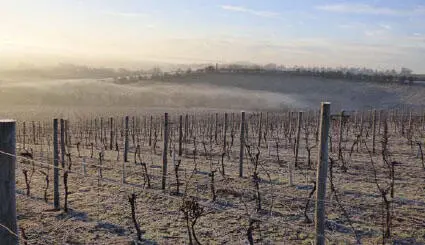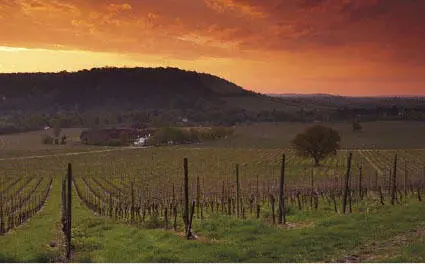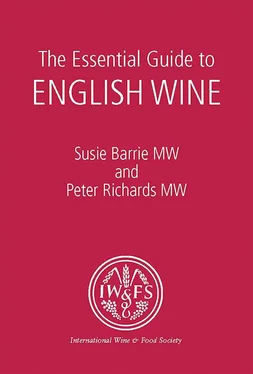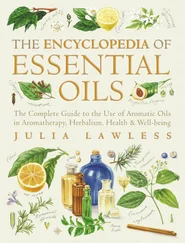“ Thirty years on from… the late 1980s, English wine stands at a juncture in its evolution [with] a sense of both exhilaration and trepidation ”
But there are challenges. Growing production raises the spectre of over-supply. Questions must be asked about how much English wine the market can and will absorb, both at home and abroad, especially if the recent trend for price inflation continues. This in turn raises the issue of commercial viability. In the UK, production (land, labour, equipment) costs are notoriously high and the industry is plagued by wildly fluctuating yields due to unpredictable weather – see Box. Capital investments are significant, especially when it comes to long-aged sparkling wines.
Within this context, there is uncertainty. Factors like climate change and Brexit have unpredictable outcomes. It’s also true to say that UK wine remains a nascent and small-scale category: winemaker Emma Rice describes UK sparkling wine as “like a fly on the wall of champagne”, accounting as it does for around 1% of annual champagne production and little over 2% of the fizz drunk in the UK every year. Will we see a time when wine-growing “hotspots” emerge, training institutions and vine nurseries flourish and vineyards lurk behind every British hedgerow? Or will we see another boom and bust?
Time will tell. The latter scenario seems unlikely given the kind of investment and professionalism that now forms the foundations of English wine. While setbacks and consolidation are normal to expect for an emerging industry, the basic proposition looks set to remain viable.
Climate
“An island of weather” is how Dr Alistair Nesbitt of Climate Wine Consulting pithily describes Britain. He notes how the British Isles lie beneath “six competing air masses”, which generate inherent climatic instability, a situation whose complexity is compounded by climate change. The UK, in short, is no easy place to be a weather forecaster or vine grower. John Atkinson MW makes wine at Tixover in Rutland. He memorably describes his occupation as, “A terrifying way to make a living: more adrenaline rush than Gold Rush.”
Rain is an issue. Vines hate having wet feet, so well drained soils are essential when there’s usually anywhere between 600-1,000 mm of precipitation per year. Rain can also cause rot late in the season and disrupt flowering early on, lowering all-important yields. In a 2016 paper by Nesbitt et al , June rainfall was identified as, “the single most determining variable in UK climatic suitability for viticulture, when expressed through yield”. Crucially, precipitation levels around flowering and harvest have not varied significantly over time, meaning it’s a challenge that’s likely to continue.

Altitude and aspect are key issues in English wine growing
Exposure is important. Given England’s northerly latitude, it makes sense to seek out south-facing slopes so sunlight is maximised. Yet this can mean exposure to prevailing southwesterly winds. Wind can help reduce disease pressure but also hinders flowering, disrupts canopies and disperses heat. Frost rears its icy head too, the risk compounded by climate change. Warming temperatures imply ever-earlier starts to the growing season, hence fragile buds appear just at the time when frost can snap, killing them and their potential fruit (as happened in 2017). Chardonnay and Pinot Noir may make top-quality wines but they also bud early so are more frost-prone than other varieties.
Climate change has meant rising temperatures. According to Nesbitt, the average growing season temperature (GST) is trending upwards: 13°C for 1954-83, 13.7°C for 1989-2003 and 14°C by 2004-13. (Incidentally, Champagne’s average GST from 1961-90 was 14.3°C.) On one level, climate change is thus benefitting England’s wine growers – the accepted threshold for fine wine production is 13°C. Yet at the same time, climate change causes more extreme and unpredictable weather events. This affects not just quality but also consistency and, in turn, long-term viability. No surprise, then, that UK wine growers view climate change as a threat as well as an opportunity.
Rigorously seeking out the best sites, implementing effective management strategies and strategic planning are thus the order of the day. In this way, the climatic risks can be minimised and the benefits of the UK’s long, temperate seasons can be maximised to give intensely flavoured, well balanced grapes ideal for sparkling and, increasingly, still wines.
“ Global warming is undoubtedly changing wine’s status quo [and] the UK is well placed to capitalise ”
Global warming is undoubtedly changing wine’s status quo. All great wine is made in marginal climates and, as that reality shifts for hitherto classic regions, the UK is well positioned to capitalise. As Nesbitt comments, “The UK has humungous potential moving forwards.”
Soils and geology
The geological map of Great Britain is a wondrous thing to behold. It’s hard not to gaze at the elegant Cretaceous limestone bands of the North and South Downs, sashaying round the sturdy sandstones of the High Weald and make sweeping wine assumptions. Similarly, it’s all too easy to note the similarities between the chalk of Champagne and this southern English geology and to conflate the two into one homogenous wine-growing whole.

Denbies sits on the limestone-rich South Downs
Yet geologists urge caution. According to Professor Alex Maltman of Aberystwyth University, the link between geology and wine is often romanticised or overstated. The notion that vineyard geology can somehow be tasted in the glass is, for him, “palpably absurd”. It is, in his view, more an issue of how myriad subtle differences in local sites (often “not readily visible” thus “less attractive than some charismatic geology”) affect the wine in the glass.
“A grower will need to assess each site on its merit,” counsels Maltman. Geology does have a part to play here. On one level, it influences topographical landscape: altitude, slope, aspect, orientation (and consequent exposure, wind patterns etc). It also has a profound bearing on drainage – a key issue in England’s rainy climate where well-drained substrates like sandstone and limestone work best. Nutrient availability and soil temperature are also influenced by geology, which may in turn have a bearing on microbiological activity, a topic currently sparking great interest for its potential impact on wine.
Nonetheless, on the basis of current evidence it is climate and aspect (in conjunction with winemaking) that seems to have the most impact on wine style and quality. For all its majesty, Britain’s geology is merely one element in a vastly more complex picture.
Viticulture and winemaking
Viticulture, in England’s young wine industry, is a lesson being learnt with every new vintage. The big challenge is working to ensure consistency and quality of yield. Site selection is key – in the words of champagne consultant Jean-Manuel Jacquinot, who played a decisive part in the initial success of English sparkling wine, “Finding the best terroirs is crucial.” Rootstocks, clones, pruning and disease management are all the subject of increasing focus and debate – ultimately, what matters is vine longevity plus wine quality and consistency in any given site. It’s also good to see organic viticulture being practised and promoted – not easy in a climate like England’s.
Читать дальше














